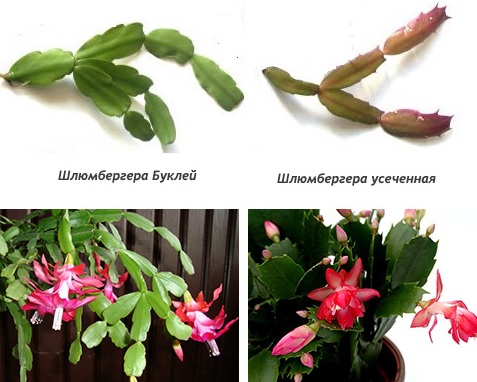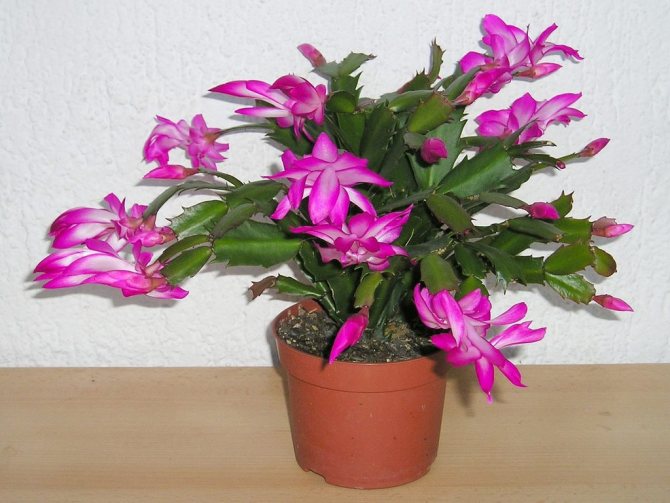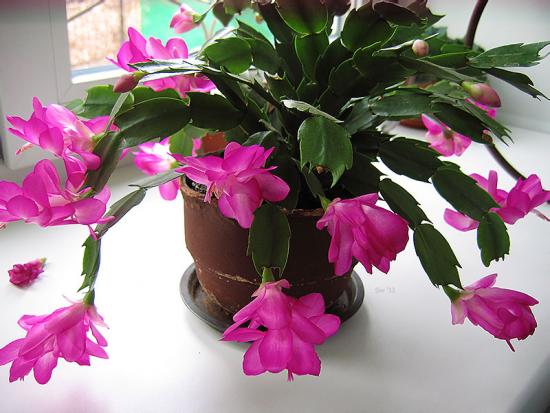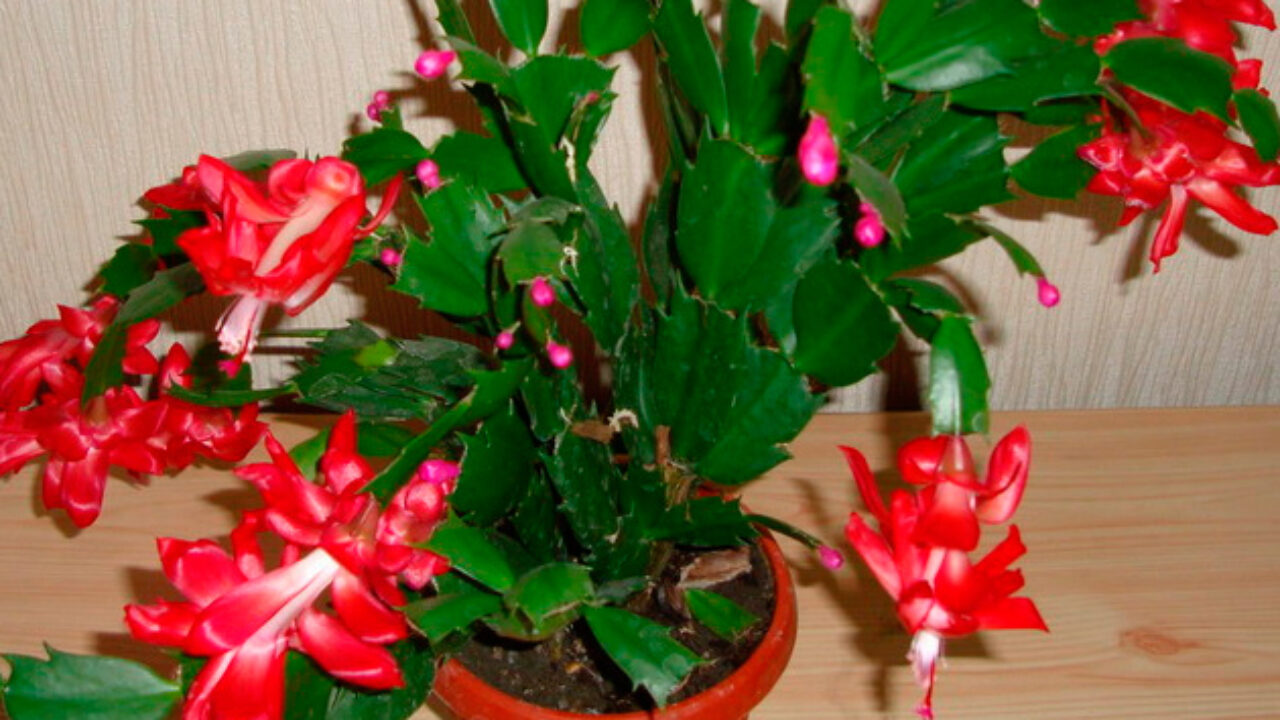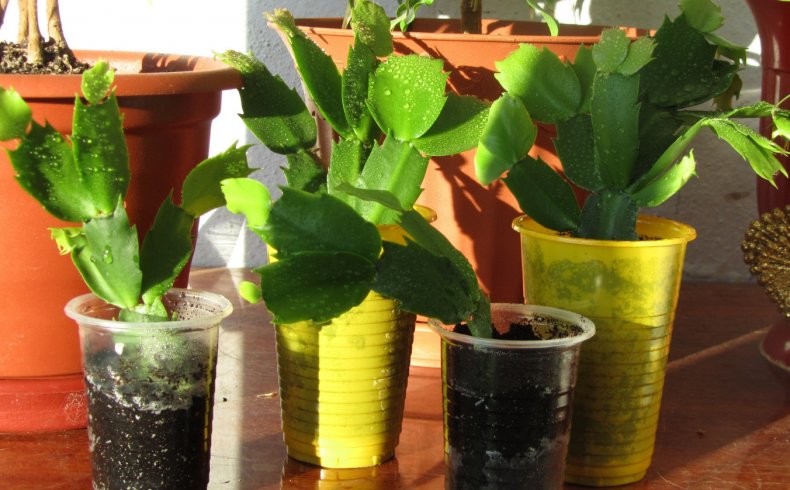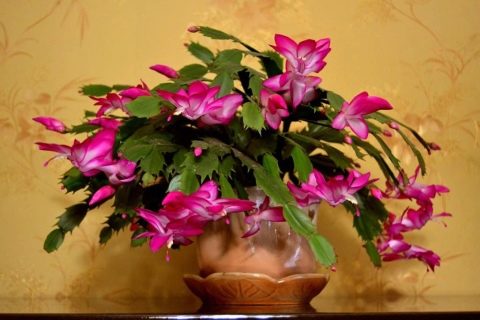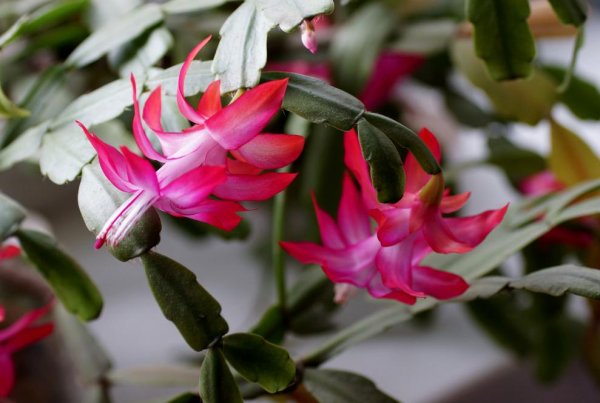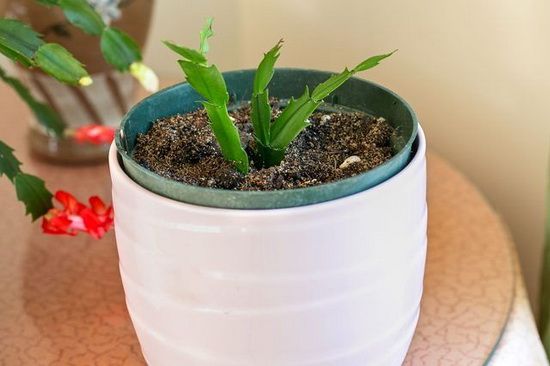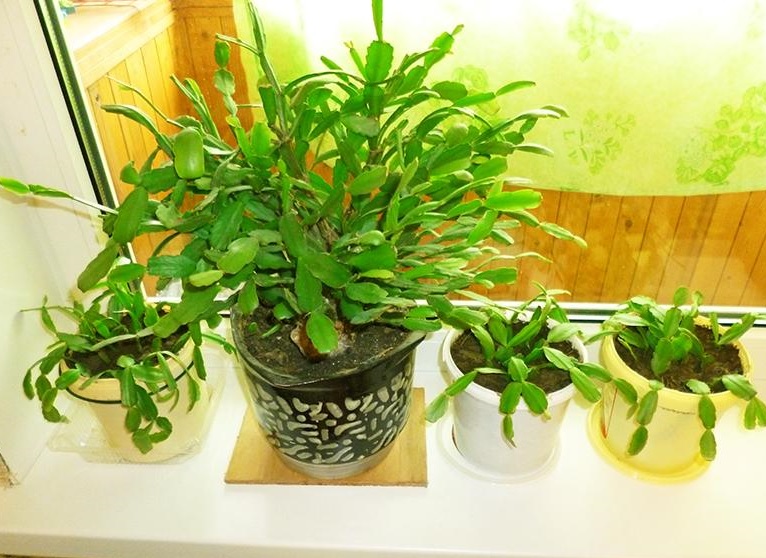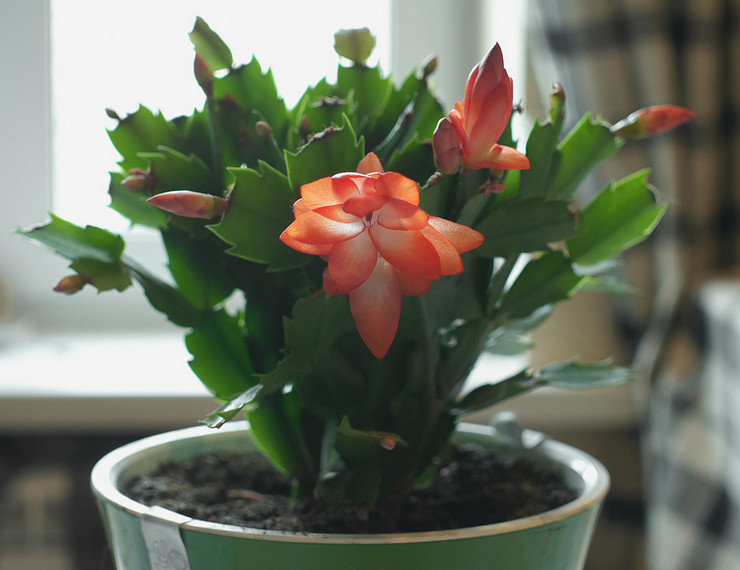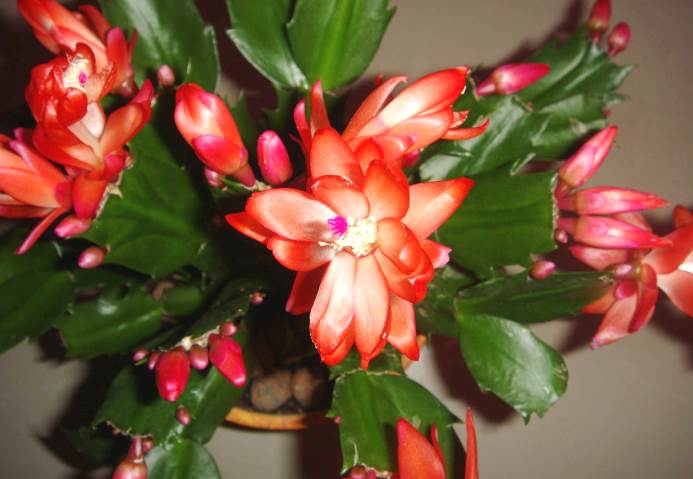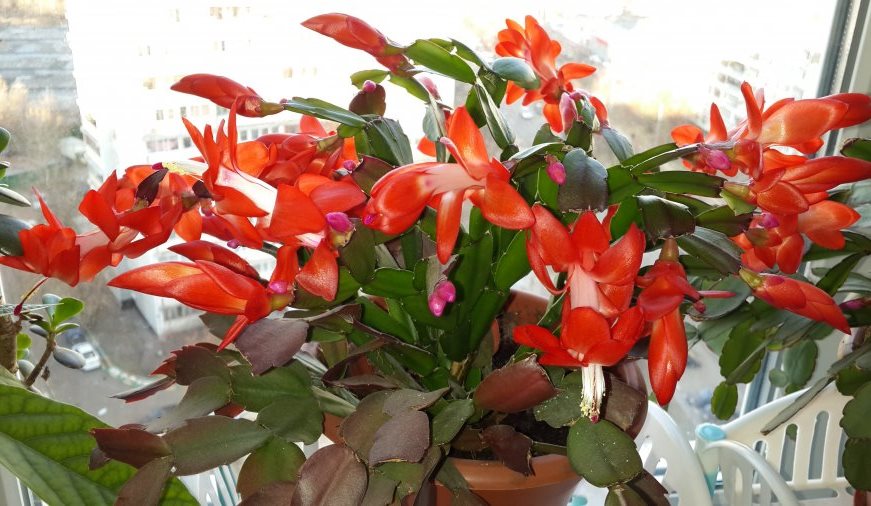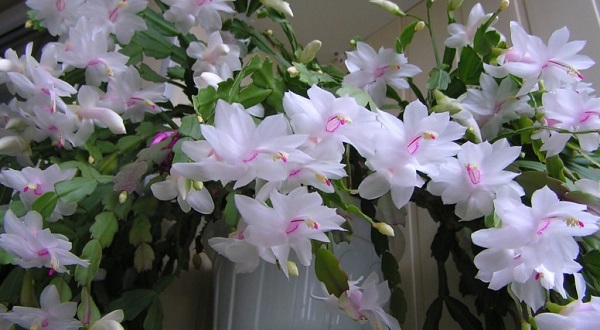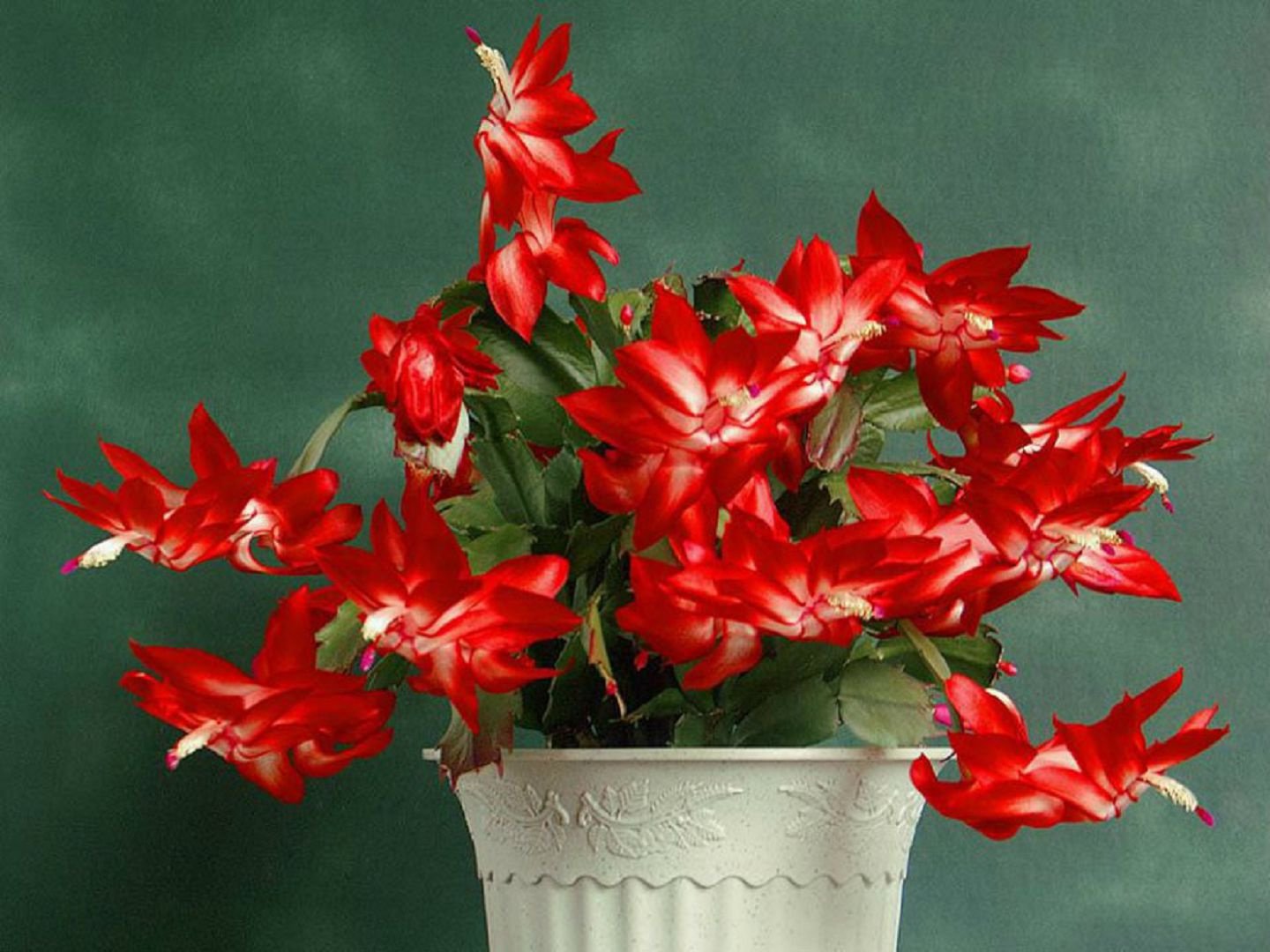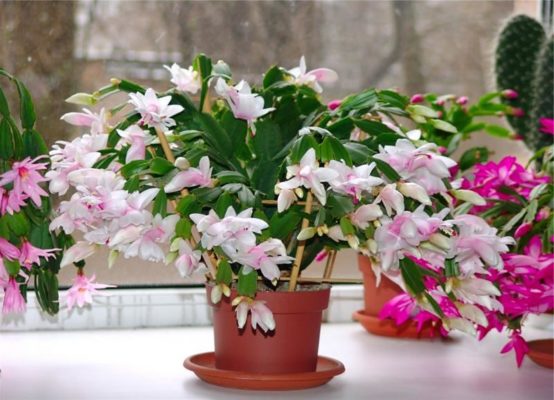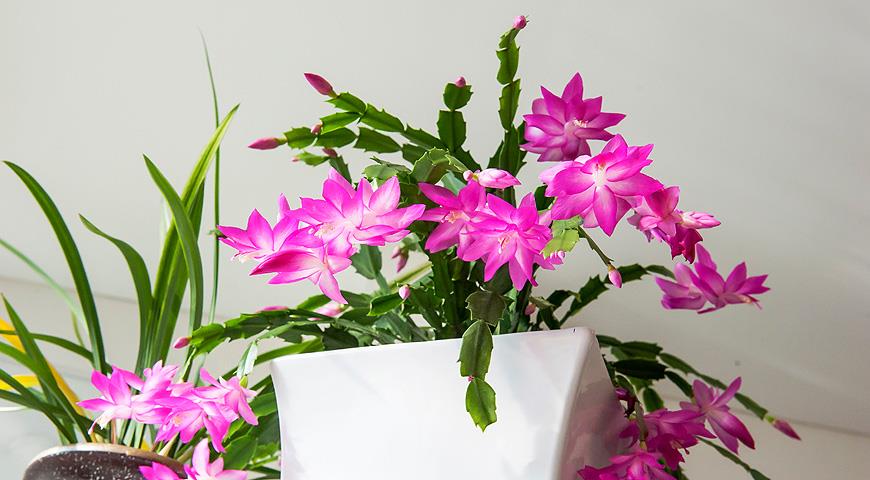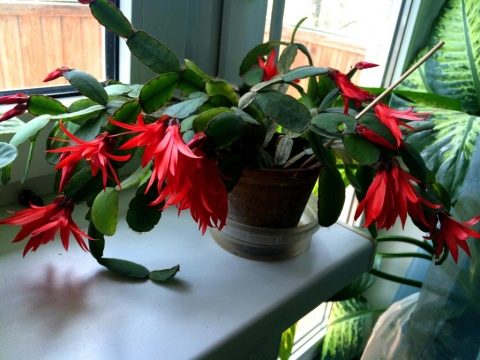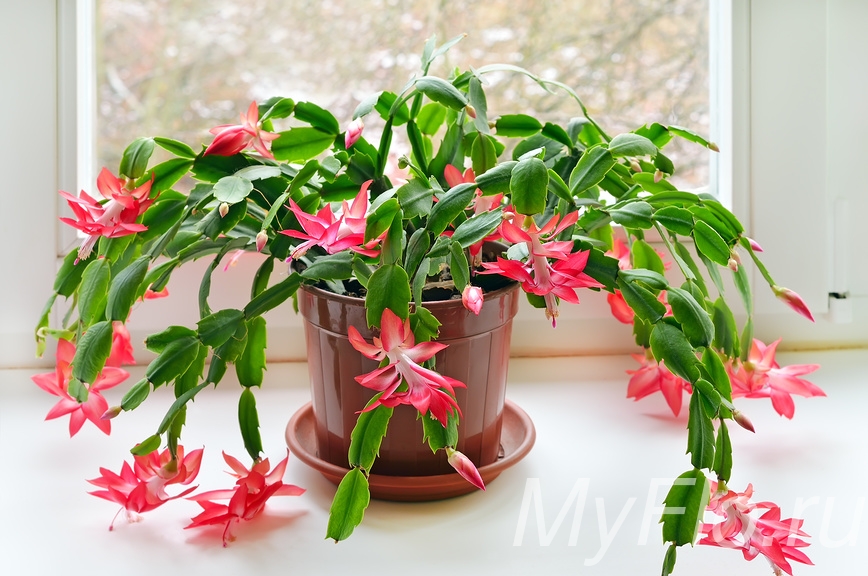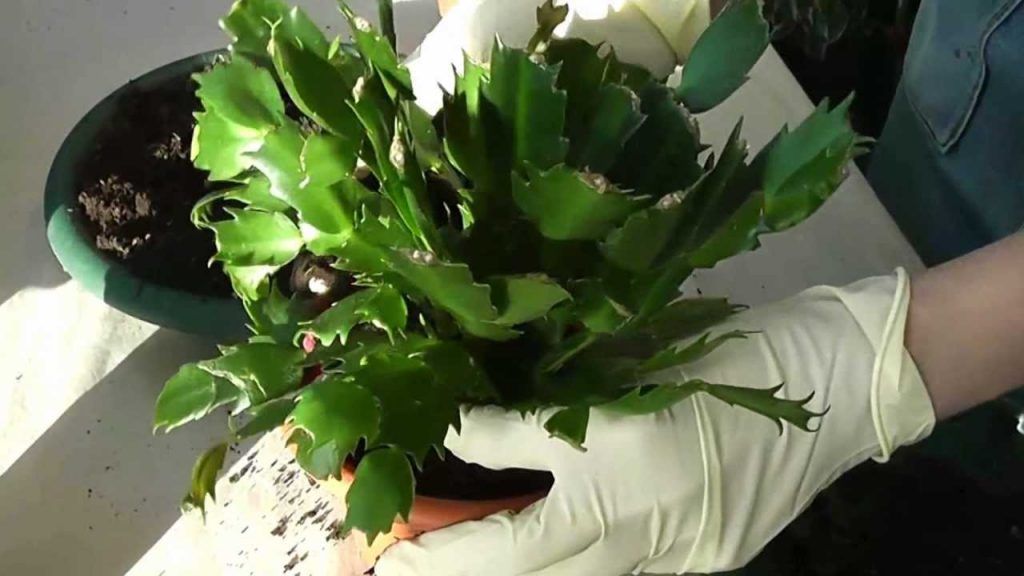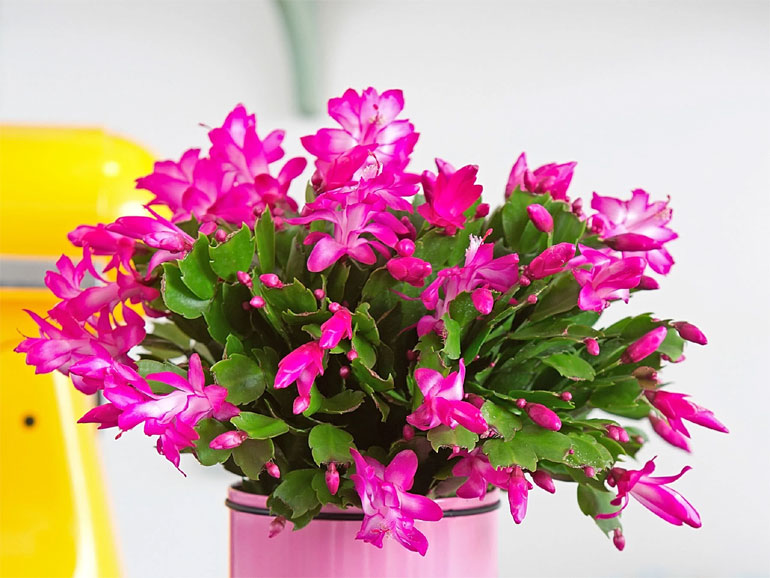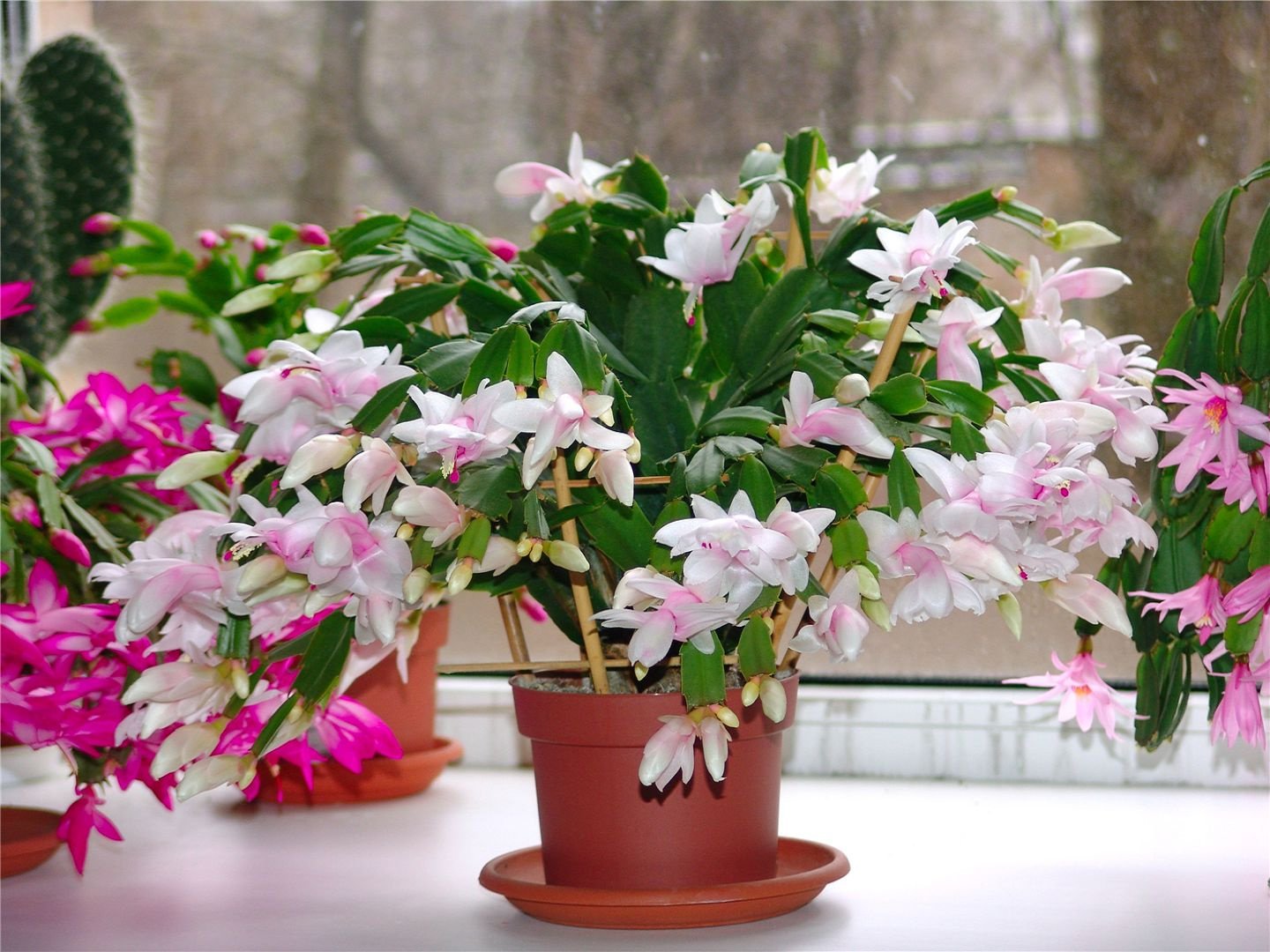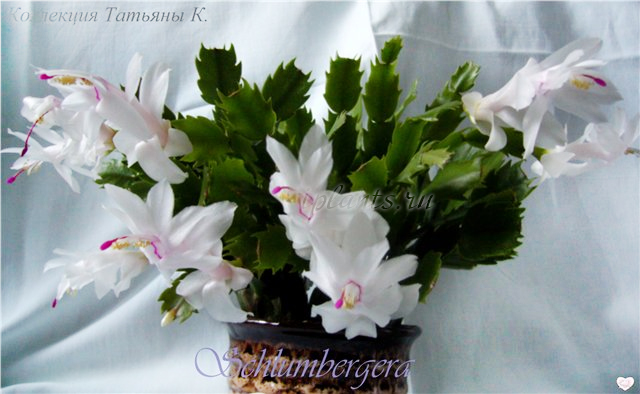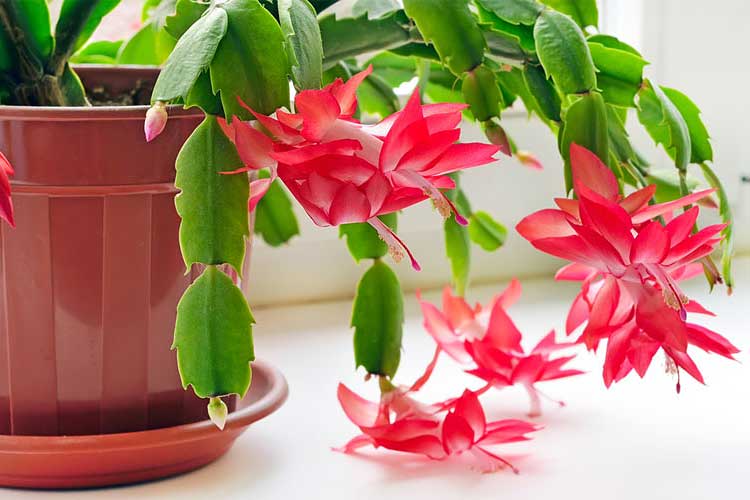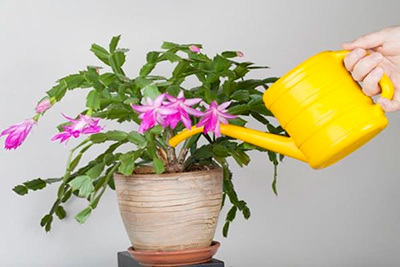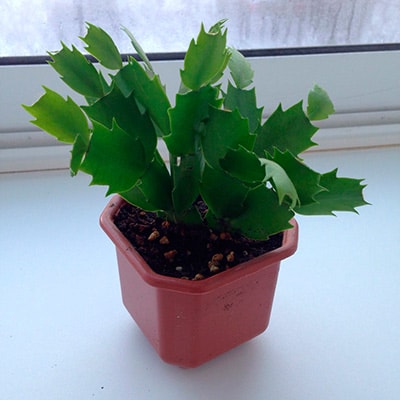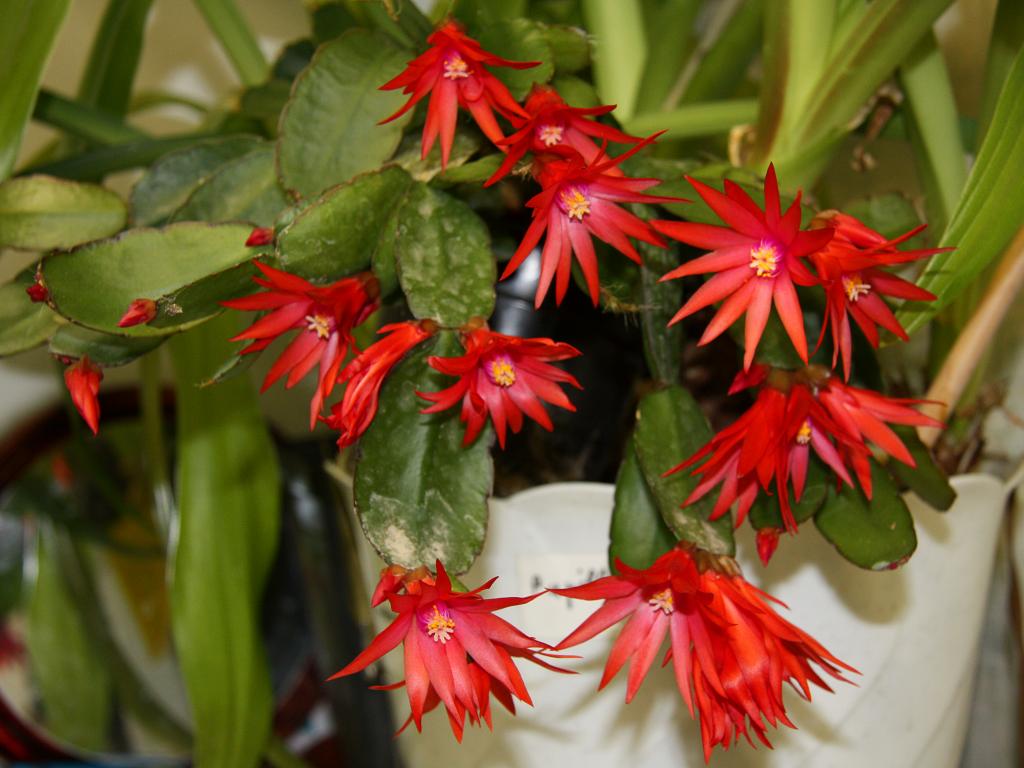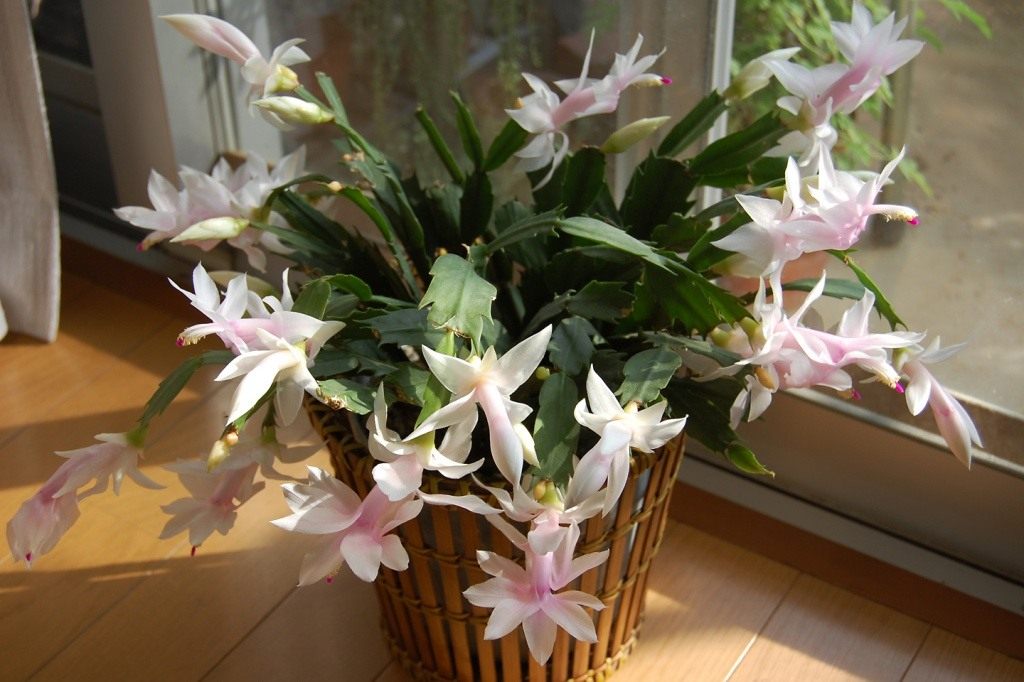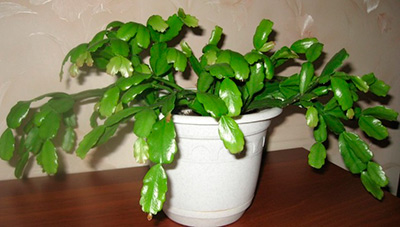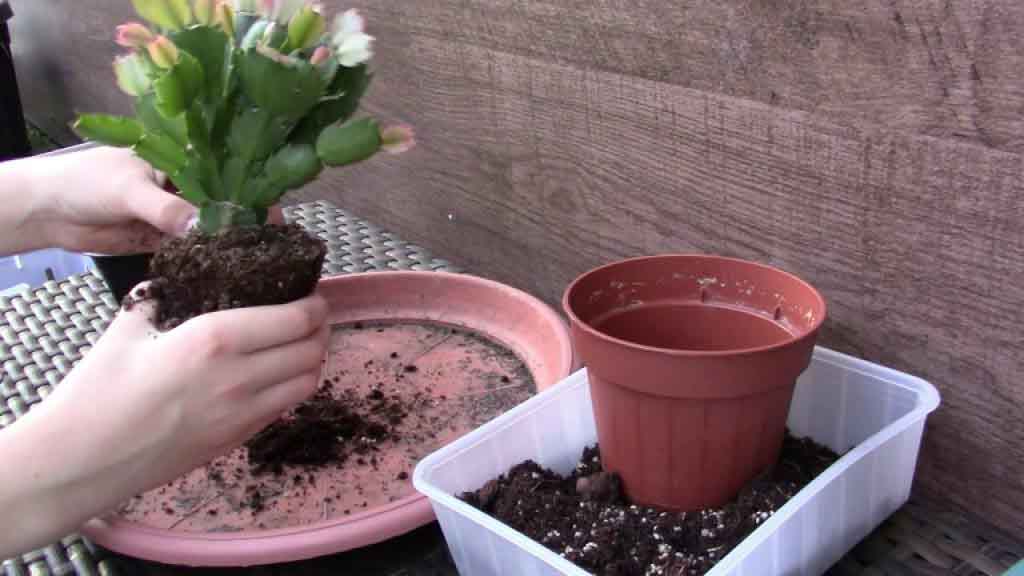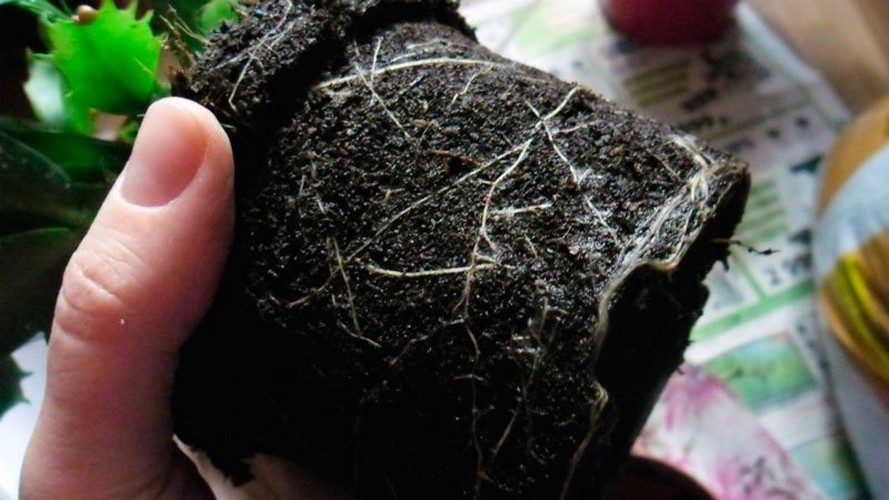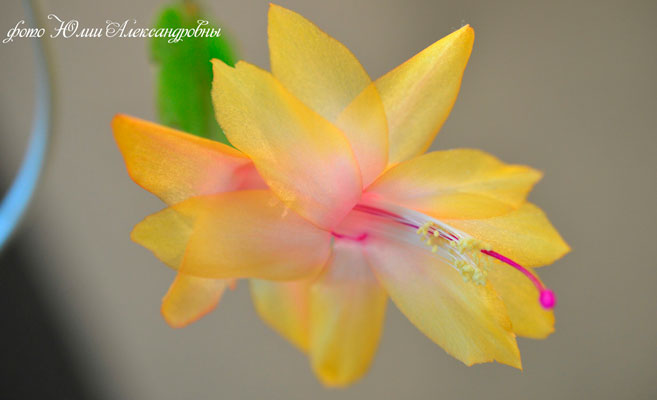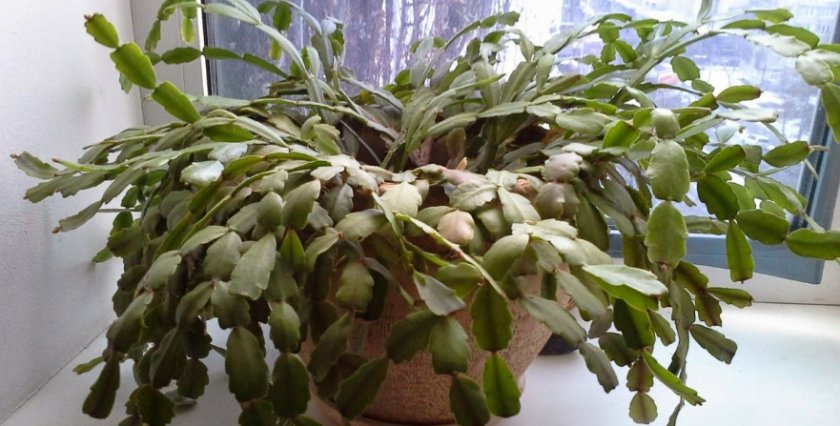Reproduction of the Decembrist
Propagated by the Decembrist cuttings having 2-3 segments. They usually take root easily at any time of the year. Can be rooted in water - in a small glass, so that the water covers the lower part of the cutting by no more than 5-10 mm. Make sure that it does not evaporate completely. In the spring, the roots usually appear within 2-3 weeks.
Decembrist cuttings can also be rooted in the ground. To do this, after cutting, dry them a little in air (4-5 hours), and, without deeply deepening, place them on a wet substrate - a mixture of universal peat soil and vermiculite. The moisture content of the substrate should be very light, slightly damp, not wet (damp), and contact with the tip of the cutting should be no more than 3-4 mm, i.e. Place the cutting on the surface of the soil and press down lightly. To prevent the stalk from falling, you need to put a stick next to it (you can tie it).
Covering with a glass jar or bag is not necessary if there is no heat and dryness. Rooting of the Decembrist happens best when the humidity is moderate, about 40-50%, so if you use a bag, do not forget to air it periodically.
Basic rules for growing a Decembrist
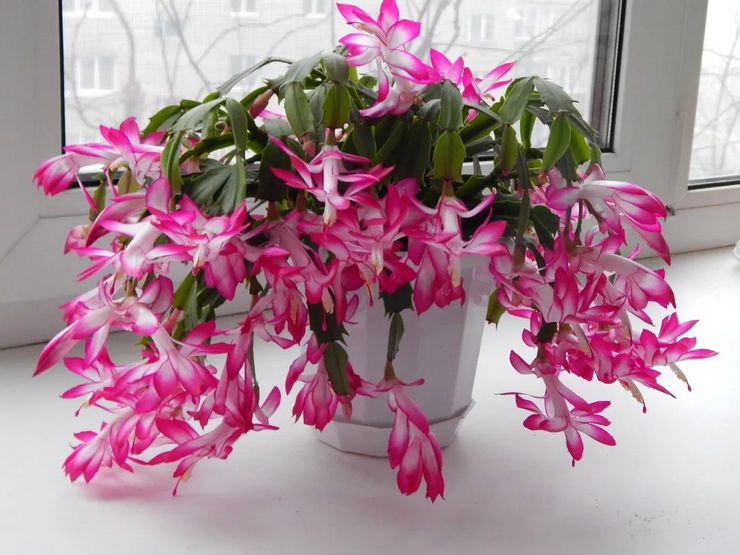
The table shows brief rules care for the Decembrist at home.
Lighting level
Should be moderate. For a zygocactus, diffused light from east or west windows will be optimal. On the south windowsill shading will be required during periods of active sun.
Content temperature
From +18 degrees and above, the flower tolerates heat. Optimum degrees in summer are about +20 degrees, in winter you can reduce the heat to +15 degrees.
Watering mode
Moderate. The soil in the pot should dry out a few centimeters in depth.
Air humidity
The room should be high. In summer, the Decembrist bush is sprayed with a spray bottle 2-3 times a week. In winter, you can do this less often, just a couple of times a month.
Top dressing
Held from early spring to September. As a fertilizer, universal mineral compositions for cacti are used.
Flowering period
Usually falls in December or January.
Dormant period
Consists of two phases. The first (before the flowering of zygocactus) occurs in the autumn months, October and November. The second (after flowering) in February and early March.
Transfer
The need for transplants occurs as the flower grows. Young bushes are transplanted annually, adults less often - once every 5-6 years.
Pruning
It is not carried out in the usual form
To form a bush, you can carefully pinch off individual segments with your hands.
Reproduction
Zygocactus can be propagated by cuttings, seeds or grafting.
Pests
Shield, mealybug and spider mite.
Diseases
Phytophthora, phytium, fusarium, bacterial diseases.
Flower Decembrist - description of the plant
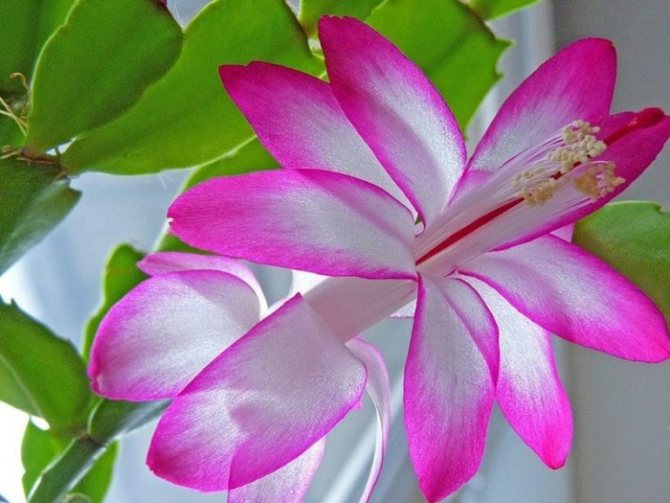
The generally recognized name for the flower is zygocactus. There is also another botanical name - Schlumberger. It was awarded in honor of the scientist from France Frederic Schlumberger, who was the discoverer of this variety of cacti.
In Russia, the plant is called the Decembrist or Christmas tree because of its peculiarity to release bright inflorescences in winter frosts. December and January blooms are associated with the fact that in nature, zygocactus blooms in mid-summer, which in South American latitudes coincides with the Russian winter.
At first, Schlumberger had exclusively red flowers. However, after breeding work, florists were able to grow plants with pinkish, white, lilac, yellow bunches. More recently, a Decembrist variety has appeared on the market, on which flowers of different colors coexist.
This beautiful tropical South American plant belongs to the epiphytic cacti. In natural nature, it grows on the root formations or trunks of Brazilian trees, forming real armfuls of flowers on hanging stems.
In general, the natural conditions for the growth of the Decembrist are as follows.
Cacti are constantly in a semi-shaded environment (due to the fact that they grow under the crown of trees)
Naturally, this cannot but affect their cautious attitude towards direct sunlight.
Schlumberger are located on branches or roots, therefore, the requirements for the soil composition are minimal. A plant does not need a rich complex of various micro- and macroelements and other useful substances.
Since zygocactus grows in the humid climate of tropical forests, it is necessary to provide appropriate conditions in the room where the container with the plant will stand.
As can be understood from the above, the Decembrist is significantly different from the "classic" cacti. Accordingly, it is necessary to provide favorable plant care, taking into account certain conditions and requirements. If done correctly, then a tropical guest will delight you flowering for more than a dozen years.
How to care for a Decembrist at home
Indoor plant is unpretentious to care for. But if you do not follow the basic rules, then the cactus may not bloom. Grooming activities are as follows:
Lighting. The Decembrist prefers bright and diffused light. Therefore, it is advisable to place the flower pot next to the windows facing the east side. During flowering, the container with the plant cannot even be moved, otherwise the flowers will fall off.
Temperature. Caring for a Decembrist at home is not difficult. Flowers are unpretentious to temperature. They can develop both at + 35 ° С and +2 ° С. The optimal indicator is + 18 ... + 25 ° С. It is at this temperature that the plant feels comfortable. The Decembrist is not afraid of drafts, therefore, in the summer months, it is advisable to take out pots with seedlings to the balcony. The only thing is that the cactus does not tolerate direct sunlight.
Watering, humidity. You need to water the cactus correctly
During the flowering period, it is important to monitor the drying out of the soil. If the ground is dry at a depth of 1-3 cm, then it's time to carry out the procedure
Before and after flowering, the amount of watering will have to be reduced. Do not water the plants with cold tap water. It contains chlorine and calcium compounds. It is best to use settled, boiled water. In hot weather, the flower must be sprayed with a spray bottle several times a day. In winter, spraying will be required 2 times a month.
Top dressing. In nature, a cactus receives nutrients from the tree on which it grows. And there are not very many nutrients. Therefore, we can say that the Decembrist does not need feeding. But if you want to enjoy a long and beautiful flowering, you will have to stock up on fertilizers. The plant reacts positively to the introduction of nitrogen, phosphorus, potassium. From March to August, it is necessary to feed the cactus 2 times a month.
Transfer. How is it carried outDecembrist transplant at home, and what kind of flower care is required in the future? Young cacti need to be replanted every year, and the new container should be larger in diameter than the previous one. The transplant is carried out in early spring, right after flowering. In terms of soil, cacti prefer to grow on fertile, light soil. To make a potting mix, you need to mix turf, sand, leafy earth, crushed coal, brick chips, wood ash. At the bottom of the container, you need to lay out a drainage layer, then fill up the soil and plant the seedlings.
Topping. In order for the plant to please with its decorative appearance, it is necessary to carry out pruning in a timely manner.For this, even scissors are not required, the excess processes must be unscrewed with rotating movements. Pinching is desirable after the flowering of the bush.

Interesting! Poinsettia home care after purchase
It is not difficult to look after the Decembrist. It is enough to complete all procedures on time, and the cactus will delight with bright colors.
Pests and diseases of the Decembrist
Enemies of the Decembrist
The Decembrist is annoyed by fungal diseases and insects. Fusarium, phytium and late blight are fungal diseases, the causative agents of which penetrate the plant from the contaminated soil, and the root collar of the plant primarily suffers from them. As a result, the flower becomes pale, gray, loses segments and withers in moist soil.
Fusarium is treated with fungicides, and phytium and phytophthora - with Maxim, Topaz, Vitaros.
If the plant is covered with a rusty bloom, then, most likely, it was struck by a spider mite - small pinpoint insects of brown, yellow or reddish color that appear on the plant in conditions of insufficient air humidity. Actellik, Fitoverm or Neoron preparations will help get rid of the tick.
Whitish lumps suddenly appeared between the shoots, similar to cotton wool - traces of the life of mealybugs, which can be neutralized with the help of Aktara.
Why does the Decembrist wither
The Decembrist withers, as we have already found out, if he fell ill with late blight or phytium. Another cause of leaf lethargy can be root disease. If the plant has lost its stability, and its trunk is swinging, then it is quite possible that the roots of the plant died from hypothermia as a result of watering with cold water in a cool room, or, conversely, from the fact that the flowerpot overheated in the sun.
Could burn the roots of the Decembrist and too strong a concentration of fertilizers. In this case, the plant must be immediately transplanted into another substrate, because the old one is saturated with concentrated fertilizer, which continues to destroy the roots.
Why does the Decembrist not bloom
The Decembrist should feel when it's time to bloom. To do this, he needs to provide a full dormant period: from the end of September to the end of November, reduce watering and stop feeding the plant by placing it in an unheated room.
Now remember how to make the Decembrist bloom: transfer the flower to a bright, warm place and start watering, thereby helping the Decembrist to wake up. Rotate the plant around its axis to achieve even illumination on all sides of the flower. As soon as the buds begin to form, make sure that the potted substrate does not dry out and that no one else from the household rearranges or turns your flower, otherwise the plant may panic and throw off the buds.
If you follow these rules, your Decembrist will definitely bloom.
Why does the Decembrist fall
Sometimes, it would seem, for no reason at all, the leaves of the Decembrist crumble. But nothing just happens. Let's try to figure it out.
It is known that the spider mite can be the cause of "leaf fall", and you already know how to get rid of it... If the pest is not detected by you, then the probable cause may be a lack of nutrients (irregular feeding, depleted substrate). Try once or twice to spray the Decembrist with a solution of fertilizers for epiphytic cacti or apply them under the root, and you will see how quickly the plant will regain its strength. If it doesn't help, change the soil.
The reason for the falling off of the end segments can be too dry air or stress transferred by the plant - a sharp temperature drop, a change in the environment, a draft, or a transplant made at the wrong time.
In the photo: Blooming Decembrist
How to take care of a Decembrist at home?
Zygocatus grow in good lightbut do not like direct sunlight. They do not tolerate temperature extremes, because in tropical forests, the weather is always warm and humid.If the care of the Decembrist is close to natural conditions, then the plant will always be healthy and beautiful.
Location
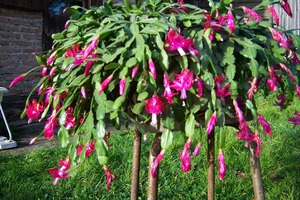 Zygocactus is best grown on eastern windowsills. It is not recommended to put a pot with a plant near the southern windows, since the segments of its stems will begin to turn yellow and crumble from direct sunlight. If the Decembrist cannot provide diffused light, it must be shaded.
Zygocactus is best grown on eastern windowsills. It is not recommended to put a pot with a plant near the southern windows, since the segments of its stems will begin to turn yellow and crumble from direct sunlight. If the Decembrist cannot provide diffused light, it must be shaded.
During bud formation and flowering, a pot of a plant should not rotate and rearrange. Otherwise, the flower will throw off its buds.
In summer, zygocactus can be grown on a balcony, loggia or garden. In this case, he needs to find a well-lit place protected from wind and direct sunlight.
The Decembrist begins to bloom at the end of November. After flowering, it must be placed in a cool room until spring.
Temperature regime
The comfortable temperature for the growth and flowering of the zygocactus ranges from 18-25C. During active growth and flowering the plant requires a temperature from + 18C to + 20C. In order for the plant to gain strength before flowering, it must be kept at a temperature in the range of 12-16C.
Watering and feeding
Caring for a Decembrist at home coincides with the conditions for growing indoor deciduous plants. He needs regular watering with settled water at room temperature.
If the air in the room is dry, then the lack of moisture is compensated for in two ways:
- Daily spraying of the plant with settled water.
- Place the flower pot on a pallet with wet drainage, peat or moss.
With the beginning of spring, the zygocactus needs monthly feeding. For this, complex fertilizers are used for flowers, the dose of which should be two times less than what is written in the instructions. In the summer, the plant is fed twice a month, and in the fall, the Decembrist does not need fertilizers.
Pruning zygocactus
When caring for a Decembrist, do not forget about pruning, after which the bush will take on an attractive appearance and bloom profusely. To do this, in June, ugly and improperly growing shoots are shortened. Moreover, experienced flower growers recommend not cutting off parts of the shoots, but unscrewing them by hand.
Decembrist transplant
 The flower is transplanted in the last days of February immediately after flowering. A pot for a Decembrist should be wide and not very high, since its roots are shallow. It is imperative to pour a drainage layer on the bottom of the pot.
The flower is transplanted in the last days of February immediately after flowering. A pot for a Decembrist should be wide and not very high, since its roots are shallow. It is imperative to pour a drainage layer on the bottom of the pot.
Decembrist prefers a light, loose substrate, which includes:
- peat - 2 parts;
- fertile soil - 1 part;
- coarse sand - 1 part.
For disinfection, you can add a little crushed coal to the mixture, and for good water permeability - brick chips or vermiculite.
Young plants are transplanted annually into pots, which are only two centimeters larger than the previous one. Mature plants need to be replanted as needed, but not more often than once every three to four years.
What is the transplant for?
After buying a Decembrist (Christmas) placed in a small container, a mandatory flower transplant is required, but not immediately, but after a while, when the plant can acclimatize
It is important to pay close attention to this process to avoid damage. Often Zygocactus or Schlumberger is overly stressed when its root system is disturbed
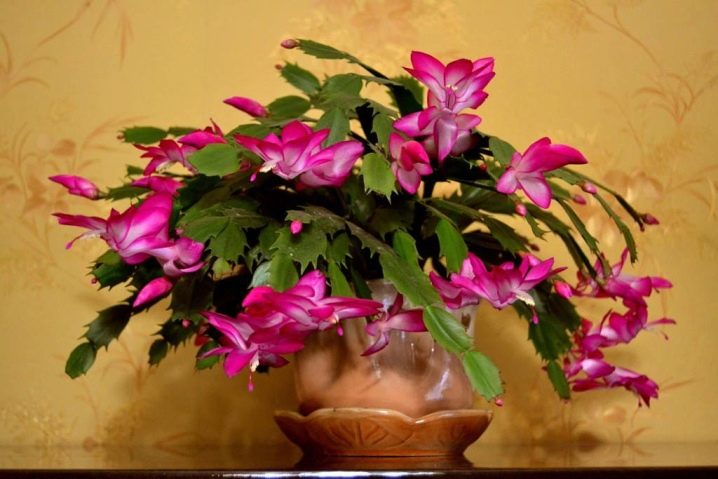
The most obvious sign that it is time to replant a plant is when roots appear on the soil surface. They sometimes come out of the drain at the bottom of the pot. If a flower stops growing or slows down, it is obvious that it has become cramped and there is no more room for development. In this case, it's time to make a transplant. After the purchase, it is worth waiting a year before increasing the pot, this is how much time it will take for the Christmas tree to get used to the existing conditions.

Flower features

Each plant has its own characteristics and the Decembrist in this case is no exception. Its main distinguishing feature is that it blooms in abundant color when all other flowers have faded and are at rest.
With regard to the conditions of his keeping in an apartment, it is optimal to place it on the south or west side. This is due to the fact that excessive exposure to the sun can provoke leaf burns and their death.
Keeping a Decembrist in an apartment is simple - it is important to remember that in the summer he especially needs fresh air and therefore it is better to take him out to the garden at this time or on a shaded balcony
An equally interesting feature of the Decembrist is that before and after the New Year, he can delight with his flowering for a long time. Often knocks out about 15-20 flowers on large bushes.

